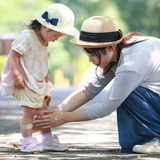In collaboration with Ovia Health—a family of apps for every stage: from cycle tracking and trying to conceive, to pregnancy and parenthood. Download the app that's right for you to get daily, personalized family health support.
As Baby starts walking, climbing, and exploring, a few accidents are bound to happen. It’s completely normal for your wayward wanderer to fall down and go boom, or to have some run-ins with the furniture.The resulting bumps, bruises and scrapes might be scary for her (and for you!) but they’re generally nothing to worry about. During this accident-prone age, it can be reassuring to know when you should be concerned, and when you don’t have to be!
Scrapes
What they are: Scrapes, medically known as abrasions, occur when the top layer of skin is scraped off leaving a raw, painful area that may bleed from one or more spots. Rug burn and “road rash,” are types of scrapes. Scrapes are tear-inducing but generally not medically serious.
What to do: Wash your hands before touching the area. Your first priority is keeping the wound clean to keep it from getting infected. Clean the wound with mild soap and clean water and remove any dirt as best you can before patting it dry. Don’t use alcohol or hydrogen peroxide on the wound (this can actually harm healthy cells in the wound and delay healing!) Instead, apply a thin layer of antiseptic cream and cover with a bandaid. Change the band aid every day and apply a new layer of ointment. Any scab that forms on the scrape should be left to come off on its own, so keep it covered to prevent tiny fingers with other plans from interfering!
When to call your provider: If you can’t get all the dirt out of the scrape with gentle washing, it’s alright to dry and cover it and let it heal. But if there are pieces of gravel, wood or another material you cannot remove, you should seek medical help. You should also call your provider if the scrape was from metal (rusty or not!) as your child may need a tetanus shot. If the scrape does not show signs of healing in two days, or if it becomes more red, painful, begins to ooze, or your child develops a fever, the wound may be infected and should be seen by a provider ASAP.
Bumps and bruises
What they are: Bruises happen when your tiny explorer bumps or bangs against something hard enough to break blood vessels underneath the skin. Right away the skin turns bright red and sometimes swells into a “bump.” This is the first stage of the bruise and it happens because blood is flowing to the injury site to help heal it. “Goose eggs,” (as bumps on a forehead are sometimes called) are caused by all this blood coming together in one small area and getting trapped. Sometimes the blood spreads out and the skin remains flat. When the pooled blood at an injury site loses oxygen over time it turns purple and blue and then lightens to green or yellow depending on skin tone. Bumps and bruises look scary, but are often no cause for concern and will heal on their own.
What to do: If your tiny explorer falls or bangs against something, put some ice or a cold pack on it right away. It will help with pain and also minimize the bruising. Use the ice for 15 minutes at a time and only once per hour. Place a towel or other barrier between the cold and your child’s skin, and use child-appropriate doses of tylenol or ibuprofen (not aspirin) for pain.
When to call your provider: Bumps or bruises that do not show signs of healing after about a week should be checked out by a healthcare provider. Bruises that keep appearing for no reason are also cause for concern and should be reported to your child’s provider.
When to seek immediate medical attention: If your child is having trouble moving or using the bruised area, it may mean there is an underlying injury such as a broken bone. For example, a bruised knee should never be so painful on its own that your child cannot stand or walk on it. You should also call your healthcare provider if your child has a bump or a bruise after an injury to the head in order to rule out a concussion. If any of the following things occur after a bump to the head, bring your child to the hospital immediately: loss of consciousness, child appearing drowsy or confused, vomiting, unequal pupils, fluid or blood draining from ears or nose, crying for hours, or child just doesn’t seem like themselves. Should any of these symptoms occur after a blow to the head, bring them to the hospital immediately and do not let them fall asleep.
Reviewed by the Ovia Health Clinical Team
Sources
- Corbett. H. (8/22/16). “Bruises in Children: What’s Normal and When To Worry.” Riley Children’s Health Website. www.rileychildrens.org/connections/bruises-in-children-whats-normal-and-when-to-worry. Accessed 13 April 2017.
- “Cuts, grazes and bruises.” Women and Children’s Health Network. 22 Aug. 2016. www.cyh.com/HealthTopics/HealthTopicDetails.aspx?id=1889&np=305&p=114#9. Accessed 14 April, 2017.
- “Debunking Myths of Wound Care.” Advanced Tissue Blog. 2 July 2014. www.advancedtissue.com/debunking-myths-wound-care/. Accessed 14 April, 2017.
- “Head Bumps and Bruises: When To Worry About Head Injuries.” Children’s Hospital St. Louis. 29 Mar. 2010. childrensmd.org/browse-by-topic/head-bumps-and-bruises-when-to-worry-about-head-injuries/. Accessed 14 April 2017.




